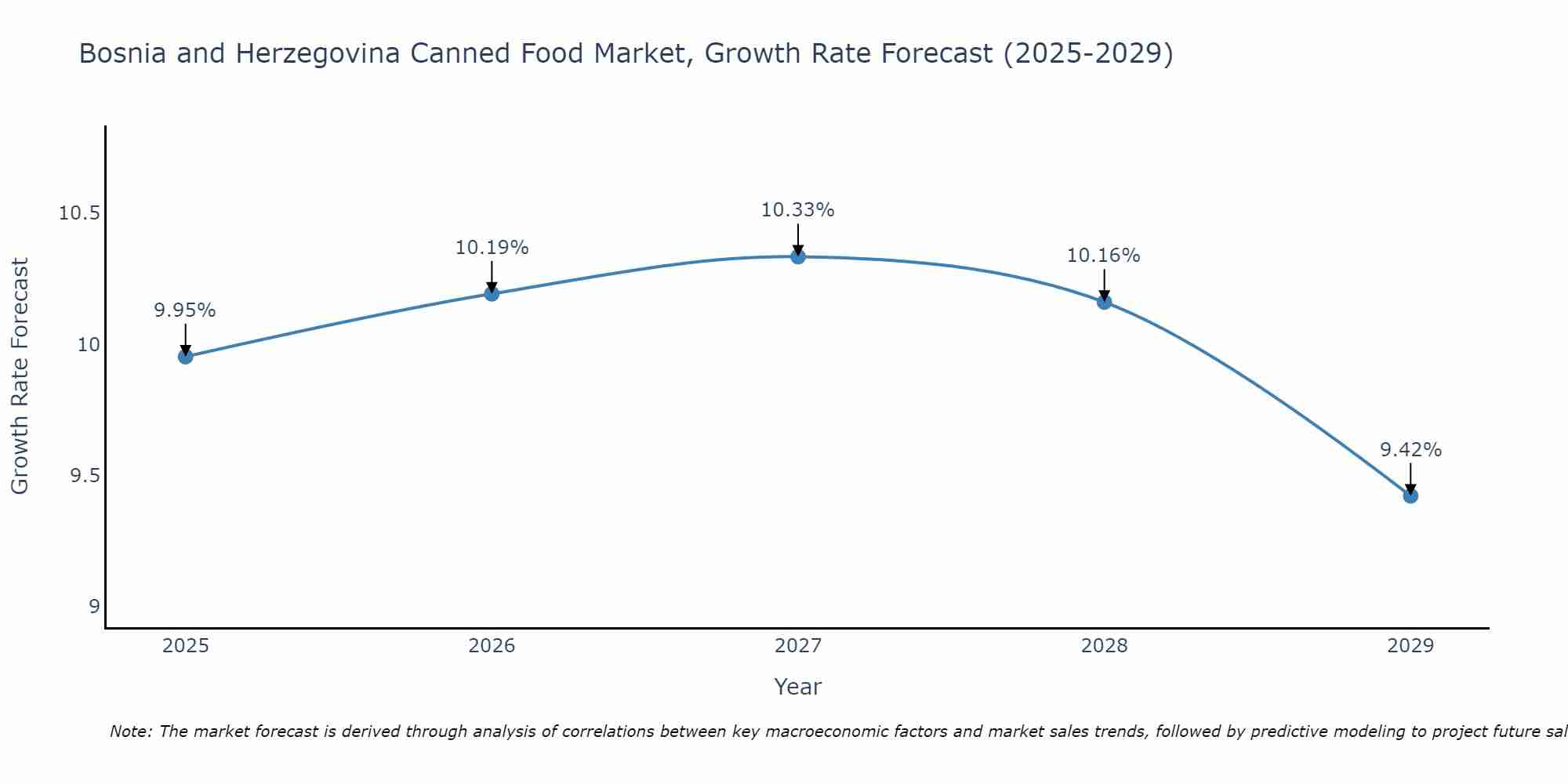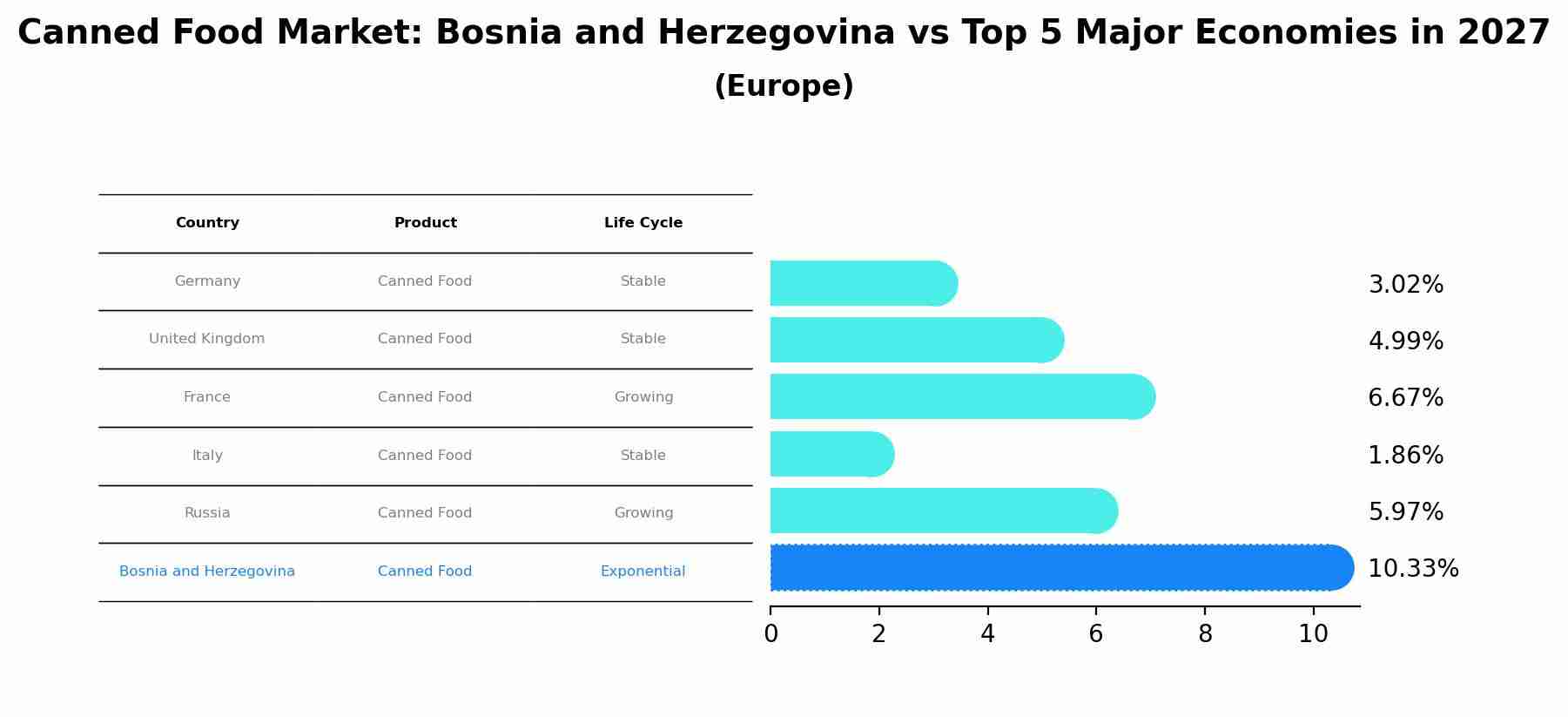Bosnia and Herzegovina Canned Food Market (2025-2031) | Size, Segmentation, Forecast, Analysis, Growth, Outlook, Revenue, Share, Value, Companies, Trends & Industry
| Product Code: ETC5007458 | Publication Date: Nov 2023 | Updated Date: Apr 2025 | Product Type: Market Research Report | |
| Publisher: 6Wresearch | Author: Sachin Kumar Rai | No. of Pages: 60 | No. of Figures: 30 | No. of Tables: 5 |
Bosnia and Herzegovina Canned Food Market Size Growth Rate
The Bosnia and Herzegovina Canned Food Market is projected to witness mixed growth rate patterns during 2025 to 2029. The growth rate begins at 9.95% in 2025, climbs to a high of 10.33% in 2027, and moderates to 9.42% by 2029.

Canned Food Market: Bosnia and Herzegovina vs Top 5 Major Economies in 2027 (Europe)
By 2027, the Canned Food market in Bosnia and Herzegovina is anticipated to reach a growth rate of 10.33%, as part of an increasingly competitive Europe region, where Germany remains at the forefront, supported by United Kingdom, France, Italy and Russia, driving innovations and market adoption across sectors.

Bosnia and Herzegovina Canned Food Market Overview
The canned food market in Bosnia and Herzegovina is driven by the demand for convenient, long-shelf-life food products. Canned foods are popular for their ease of storage and preparation, making them a staple in many households. Market growth is supported by rising urbanization and busy lifestyles. Challenges include competition from fresh and frozen food products and health concerns related to preservatives. The market is expected to grow with ongoing consumer preference for convenient and ready-to-eat food options.
Drivers of the market
The canned food market in Bosnia and Herzegovina is influenced by the growing demand for convenient and long-lasting food products. Canned foods provide ease of storage and extended shelf life, which appeals to consumers looking for quick meal solutions. The rising trend of urbanization and busy lifestyles boosts the demand for canned foods. Additionally, the variety of canned food products, including fruits, vegetables, and meats, supports market growth.
Challenges of the market
Challenges in the canned food market include fluctuations in raw material prices and supply chain disruptions, which can affect production costs and product availability. Regulatory requirements related to food safety, labeling, and quality control can add to operational costs. Additionally, the market faces competition from both local and international brands, which can impact market share and pricing. There are also concerns about sustainability and environmental impact related to packaging and production processes.
Government Policy of the market
The canned food market in Bosnia and Herzegovina is shaped by government policies on food safety and quality standards. Regulations that mandate proper labeling, preservation methods, and hygiene standards for canned foods drive market growth. Policies promoting local food processing and reducing import tariffs on canned goods influence market conditions. Additionally, trade agreements affect the availability and cost of canned foods.
Key Highlights of the Report:
- Bosnia and Herzegovina Canned Food Market Outlook
- Market Size of Bosnia and Herzegovina Canned Food Market, 2024
- Forecast of Bosnia and Herzegovina Canned Food Market, 2031
- Historical Data and Forecast of Bosnia and Herzegovina Canned Food Revenues & Volume for the Period 2021-2031
- Bosnia and Herzegovina Canned Food Market Trend Evolution
- Bosnia and Herzegovina Canned Food Market Drivers and Challenges
- Bosnia and Herzegovina Canned Food Price Trends
- Bosnia and Herzegovina Canned Food Porter`s Five Forces
- Bosnia and Herzegovina Canned Food Industry Life Cycle
- Historical Data and Forecast of Bosnia and Herzegovina Canned Food Market Revenues & Volume By Product Type for the Period 2021-2031
- Historical Data and Forecast of Bosnia and Herzegovina Canned Food Market Revenues & Volume By Canned meat & seafood for the Period 2021-2031
- Historical Data and Forecast of Bosnia and Herzegovina Canned Food Market Revenues & Volume By Canned fruit & vegetables for the Period 2021-2031
- Historical Data and Forecast of Bosnia and Herzegovina Canned Food Market Revenues & Volume By Canned ready meals for the Period 2021-2031
- Historical Data and Forecast of Bosnia and Herzegovina Canned Food Market Revenues & Volume By Others for the Period 2021-2031
- Historical Data and Forecast of Bosnia and Herzegovina Canned Food Market Revenues & Volume By Type for the Period 2021-2031
- Historical Data and Forecast of Bosnia and Herzegovina Canned Food Market Revenues & Volume By Organic for the Period 2021-2031
- Historical Data and Forecast of Bosnia and Herzegovina Canned Food Market Revenues & Volume By Conventional for the Period 2021-2031
- Historical Data and Forecast of Bosnia and Herzegovina Canned Food Market Revenues & Volume By Distribution Channel for the Period 2021-2031
- Historical Data and Forecast of Bosnia and Herzegovina Canned Food Market Revenues & Volume By Supermarket/Hypermarket for the Period 2021-2031
- Historical Data and Forecast of Bosnia and Herzegovina Canned Food Market Revenues & Volume By Convenience stores for the Period 2021-2031
- Historical Data and Forecast of Bosnia and Herzegovina Canned Food Market Revenues & Volume By E-commerce for the Period 2021-2031
- Historical Data and Forecast of Bosnia and Herzegovina Canned Food Market Revenues & Volume By Others for the Period 2021-2031
- Bosnia and Herzegovina Canned Food Import Export Trade Statistics
- Market Opportunity Assessment By Product Type
- Market Opportunity Assessment By Type
- Market Opportunity Assessment By Distribution Channel
- Bosnia and Herzegovina Canned Food Top Companies Market Share
- Bosnia and Herzegovina Canned Food Competitive Benchmarking By Technical and Operational Parameters
- Bosnia and Herzegovina Canned Food Company Profiles
- Bosnia and Herzegovina Canned Food Key Strategic Recommendations
Frequently Asked Questions About the Market Study (FAQs):
1 Executive Summary |
2 Introduction |
2.1 Key Highlights of the Report |
2.2 Report Description |
2.3 Market Scope & Segmentation |
2.4 Research Methodology |
2.5 Assumptions |
3 Bosnia and Herzegovina Canned Food Market Overview |
3.1 Bosnia and Herzegovina Country Macro Economic Indicators |
3.2 Bosnia and Herzegovina Canned Food Market Revenues & Volume, 2021 & 2031F |
3.3 Bosnia and Herzegovina Canned Food Market - Industry Life Cycle |
3.4 Bosnia and Herzegovina Canned Food Market - Porter's Five Forces |
3.5 Bosnia and Herzegovina Canned Food Market Revenues & Volume Share, By Product Type, 2021 & 2031F |
3.6 Bosnia and Herzegovina Canned Food Market Revenues & Volume Share, By Type, 2021 & 2031F |
3.7 Bosnia and Herzegovina Canned Food Market Revenues & Volume Share, By Distribution Channel, 2021 & 2031F |
4 Bosnia and Herzegovina Canned Food Market Dynamics |
4.1 Impact Analysis |
4.2 Market Drivers |
4.3 Market Restraints |
5 Bosnia and Herzegovina Canned Food Market Trends |
6 Bosnia and Herzegovina Canned Food Market Segmentations |
6.1 Bosnia and Herzegovina Canned Food Market, By Product Type |
6.1.1 Overview and Analysis |
6.1.2 Bosnia and Herzegovina Canned Food Market Revenues & Volume, By Canned meat & seafood, 2021-2031F | 6.1.4 Bosnia and Herzegovina Canned Food Market Revenues & Volume, By Canned fruit & vegetables, 2021-2031F |
6.1.4 Bosnia and Herzegovina Canned Food Market Revenues & Volume, By Canned ready meals, 2021-2031F |
6.1.5 Bosnia and Herzegovina Canned Food Market Revenues & Volume, By Others, 2021-2031F |
6.2 Bosnia and Herzegovina Canned Food Market, By Type |
6.2.1 Overview and Analysis |
6.2.2 Bosnia and Herzegovina Canned Food Market Revenues & Volume, By Organic, 2021-2031F |
6.2.3 Bosnia and Herzegovina Canned Food Market Revenues & Volume, By Conventional, 2021-2031F |
6.3 Bosnia and Herzegovina Canned Food Market, By Distribution Channel |
6.3.1 Overview and Analysis |
6.3.2 Bosnia and Herzegovina Canned Food Market Revenues & Volume, By Supermarket/Hypermarket, 2021-2031F |
6.3.3 Bosnia and Herzegovina Canned Food Market Revenues & Volume, By Convenience stores, 2021-2031F |
6.3.4 Bosnia and Herzegovina Canned Food Market Revenues & Volume, By E-commerce, 2021-2031F |
6.3.5 Bosnia and Herzegovina Canned Food Market Revenues & Volume, By Others, 2021-2031F |
7 Bosnia and Herzegovina Canned Food Market Import-Export Trade Statistics |
7.1 Bosnia and Herzegovina Canned Food Market Export to Major Countries |
7.2 Bosnia and Herzegovina Canned Food Market Imports from Major Countries |
8 Bosnia and Herzegovina Canned Food Market Key Performance Indicators |
9 Bosnia and Herzegovina Canned Food Market - Opportunity Assessment |
9.1 Bosnia and Herzegovina Canned Food Market Opportunity Assessment, By Product Type, 2021 & 2031F |
9.2 Bosnia and Herzegovina Canned Food Market Opportunity Assessment, By Type, 2021 & 2031F |
9.3 Bosnia and Herzegovina Canned Food Market Opportunity Assessment, By Distribution Channel, 2021 & 2031F |
10 Bosnia and Herzegovina Canned Food Market - Competitive Landscape |
10.1 Bosnia and Herzegovina Canned Food Market Revenue Share, By Companies, 2024 |
10.2 Bosnia and Herzegovina Canned Food Market Competitive Benchmarking, By Operating and Technical Parameters |
11 Company Profiles |
12 Recommendations | 13 Disclaimer |
- Single User License$ 1,995
- Department License$ 2,400
- Site License$ 3,120
- Global License$ 3,795
Search
Thought Leadership and Analyst Meet
Our Clients
Related Reports
- Canada Oil and Gas Market (2026-2032) | Share, Segmentation, Value, Industry, Trends, Forecast, Analysis, Size & Revenue, Growth, Competitive Landscape, Outlook, Companies
- Germany Breakfast Food Market (2026-2032) | Industry, Share, Growth, Size, Companies, Value, Analysis, Revenue, Trends, Forecast & Outlook
- Australia Briquette Market (2025-2031) | Growth, Size, Revenue, Forecast, Analysis, Trends, Value, Share, Industry & Companies
- Vietnam System Integrator Market (2025-2031) | Size, Companies, Analysis, Industry, Value, Forecast, Growth, Trends, Revenue & Share
- ASEAN and Thailand Brain Health Supplements Market (2025-2031) | Strategy, Consumer Insights, Analysis, Investment Trends, Opportunities, Growth, Size, Share, Industry, Revenue, Segments, Value, Segmentation, Supply, Forecast, Restraints, Outlook, Competition, Drivers, Trends, Demand, Pricing Analysis, Competitive, Strategic Insights, Companies, Challenges
- ASEAN Bearings Market (2025-2031) | Strategy, Consumer Insights, Analysis, Investment Trends, Opportunities, Growth, Size, Share, Industry, Revenue, Segments, Value, Segmentation, Supply, Forecast, Restraints, Outlook, Competition, Drivers, Trends, Demand, Pricing Analysis, Competitive, Strategic Insights, Companies, Challenges
- Europe Flooring Market (2025-2031) | Outlook, Share, Industry, Trends, Forecast, Companies, Revenue, Size, Analysis, Growth & Value
- Saudi Arabia Manlift Market (2025-2031) | Outlook, Size, Growth, Trends, Companies, Industry, Revenue, Value, Share, Forecast & Analysis
- Uganda Excavator, Crane, and Wheel Loaders Market (2025-2031) | Strategy, Consumer Insights, Analysis, Investment Trends, Opportunities, Growth, Size, Share, Industry, Revenue, Segments, Value, Segmentation, Supply, Forecast, Restraints, Outlook, Competition, Drivers, Trends, Demand, Pricing Analysis, Competitive, Strategic Insights, Companies, Challenges
- Rwanda Excavator, Crane, and Wheel Loaders Market (2025-2031) | Strategy, Consumer Insights, Analysis, Investment Trends, Opportunities, Growth, Size, Share, Industry, Revenue, Segments, Value, Segmentation, Supply, Forecast, Restraints, Outlook, Competition, Drivers, Trends, Demand, Pricing Analysis, Competitive, Strategic Insights, Companies, Challenges
Industry Events and Analyst Meet
Whitepaper
- Middle East & Africa Commercial Security Market Click here to view more.
- Middle East & Africa Fire Safety Systems & Equipment Market Click here to view more.
- GCC Drone Market Click here to view more.
- Middle East Lighting Fixture Market Click here to view more.
- GCC Physical & Perimeter Security Market Click here to view more.
6WResearch In News
- Doha a strategic location for EV manufacturing hub: IPA Qatar
- Demand for luxury TVs surging in the GCC, says Samsung
- Empowering Growth: The Thriving Journey of Bangladesh’s Cable Industry
- Demand for luxury TVs surging in the GCC, says Samsung
- Video call with a traditional healer? Once unthinkable, it’s now common in South Africa
- Intelligent Buildings To Smooth GCC’s Path To Net Zero


















